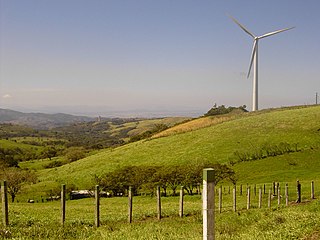
Tilarán is a canton in the Guanacaste province of Costa Rica. The head city is in Tilarán district.

Montes de Oro is a canton in the Puntarenas province of Costa Rica. The head city is in Miramar district.
Limón is a canton in the Limón province of Costa Rica. The head city is in Limón district.
Sierra, locally known as Las Minas, is a district of the Abangares canton, in the Guanacaste province of Costa Rica. It is well known as a historical mining town of Costa Rica, located in the north west Pacific Region. It goes from an altitude of 210 meters to 1200 meters.

Tronadora is a district of the Tilarán canton, in the Guanacaste province of Costa Rica. It is located on the west shore of Lake Arenal. It is connected by road to Tejona and Tilarán along Route 142. The weather is changeable due to the proximity of the confluence of the Pacific coast weather pattern and the inland lake weather pattern. It is drier and cooler than the Pacific coast due to the elevation of 614 meters.
Arenal is a district of the Tilarán canton, in the Guanacaste province of Costa Rica. The relocated town of Nuevo Arenal is located in this district.
San Juan is a district of the Abangares canton, in the Guanacaste province of Costa Rica.
Colorado is a district of the Abangares canton, in the Guanacaste province of Costa Rica.
San Rafael is a district of the Escazú canton, in the San José province of Costa Rica.

San Ignacio is a district of the Acosta canton, in the San José province of Costa Rica.
Carara is a district of the Turrubares canton, in the San José province of Costa Rica.
Guácima is a district of the Alajuela canton, in the Alajuela province of Costa Rica.
San Juan is a district of the San Ramón canton, in the Alajuela province of Costa Rica.
San José is a district of the Grecia canton, in the Alajuela province of Costa Rica.
San Roque is a district of the Grecia canton, in the Alajuela province of Costa Rica.
Bolívar is a district of the Grecia canton, in the Alajuela province of Costa Rica.
Quebrada Grande is a district of the Tilarán canton, in the Guanacaste province of Costa Rica.
Santa Rosa is a district of the Tilarán canton, in the Guanacaste province of Costa Rica.
Líbano is a district of the Tilarán canton, in the Guanacaste province of Costa Rica.
Tierras Morenas is a district of the Tilarán canton, in the Guanacaste province of Costa Rica.







